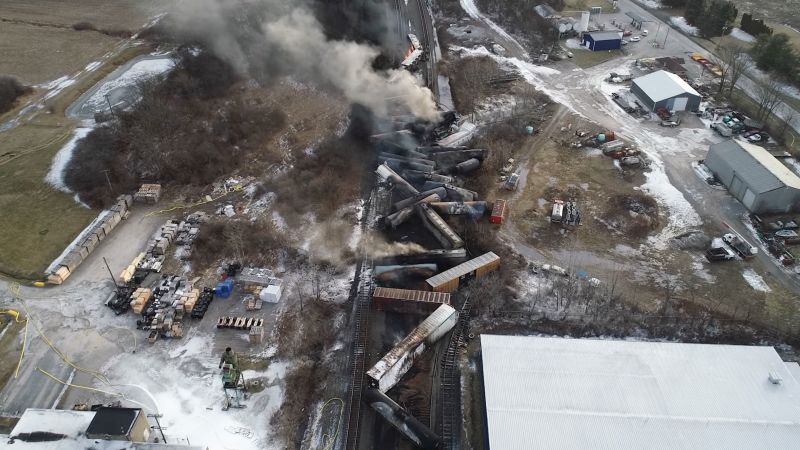Feb. 3 — Around 8:12 p.m., sparks shoot out from underneath the Norfolk Southern freight train as it passes through Salem, Ohio, surveillance video shows.
Around 8:55 p.m., 38 of the train’s cars derail in East Palestine. The derailed equipment includes 11 tank cars carrying hazardous materials that ignited, fueling fires that damage another dozen cars, the National Transportation Safety Board says.
Feb. 4 — Members of the US Environmental Protection Agency arrive hours after the derailment and start monitoring the air for volatile organic compounds (VOCs) such as vinyl chloride and butyl acrylate, which were on the train and can be harmful to people, the agency says.
EPA contractors install booms and underflow dams to try to restrict the flow of contaminated water and collect floating material to mitigate any possible impacts to Sulphur Run and Leslie Run streams.
Feb. 5 — Gov. Mike DeWine activates the Ohio National Guard to assist local authorities.
Officials issue a shelter-in-place order for the entire town of roughly 5,000 people. An evacuation order is issued for the area within a mile radius of the train crash near James Street, due to the risk of an explosion.
EPA community air monitoring readings do not detect any contaminants of concern, the agency says. Norfolk Southern’s contractor continues to conduct air monitoring, it says.
The National Transportation Safety Board is on scene to gather evidence and asks the community to submit photos or videos of the incident.
NTSB conducts a one-mile walk-through of track outside the hot zone and identifies the point of derailment. NTSB Member Michael Graham says the preliminary report is expected in four to eight weeks.
Aeration pumps – which help treat contamination by injecting oxygen into the water – begin operating at three locations along Sulphur Run and its confluence with Leslie Run. EPA and Norfolk Southern contractors collect surface water samples for analysis.
The East Palestine water treatment plant, which treats water sourced from public wells, confirms there were no adverse effects to the plant, the EPA says.
Feb. 6 — To help prevent a deadly explosion of vinyl chloride, crews conduct a controlled detonation involving cars containing the toxic substance. The chemical was drained into a trench and burned off. “The detonation went perfect,” a Norfolk Southern official said.
After the breach, officials detected “slightly elevated” readings of the phosgene and hydrogen chloride in the burn area and “only one minor hit for the hydrogen chloride downwind of the burn area” within the exclusion zone, an EPA official said. He said such readings were expected after the controlled release.
Feb. 7 — Residents in the area are told they may smell odors coming from the site because the byproducts of the controlled burn have a low odor threshold – meaning people may smell these contaminants at levels much lower than what is considered hazardous, the EPA says.
The EPA continues to perform air monitoring and work with Norfolk Southern, health departments and other responding agencies to develop procedures for safely reoccupying the evacuated areas.
The 52nd Civil Service Team conducts air monitoring in three public administration buildings and collects air samples from each building, according to the EPA.
The EPA says it is investigating a complaint of odors from the Darlington Township, Pennsylvania, fire station. A team with air monitoring equipment goes to the station, where it does not observe any contaminants above detection limits.
Feb. 8 — The evacuation order is lifted, five days after the derailment, after water samples are analyzed overnight. The results lead officials to deem the water is safe, East Palestine Fire Chief Keith Drabick says at a news conference.
The EPA and Ohio EPA find spilled materials in Sulphur Run, the EPA says. Oily product is leaking from a tank car and pooling onto the soil. Norfolk Southern is notified of the spill and begins removing the product using a vacuum truck.
A local couple and business owner file the first-class action lawsuit against Norfolk Southern, CNN reports. The suit accuses the rail company of negligence, stating it failed to exercise reasonable care for residents, with businesses adversely affected by the derailment and chemical spill.
Feb. 9 — EPA continues stationary and roaming air monitoring surrounding the derailment scene.
Despite officials deeming the air and water samples safe, some residents still have concerns. Residents are encouraged to get their homes deep-cleaned and seek medical attention, if necessary, officials say at a news conference.
The EPA works with Ohio EPA to investigate remaining soil contamination and any impacts to surface water, the agency says. EPA collects samples of spilled material near the derailment site and in Sulphur Run.
Officials say schools will remain closed until further notice from the superintendent.
Mayor Trent Conaway ensures that the school building will be scrubbed “head to toe” and air tested before any child walks back into the building.
Feb. 10 — Some residents say when they returned to their homes in East Palestine, within a half-hour they developed a rash and nausea.
EPA is assisting with voluntary residential air screening appointments offered by Norfolk Southern, the agency says. Crews have screened indoor air at 46 homes. There are over 400 requests for indoor air screening remaining.
To increase the rate of screening, Norfolk Southern – with EPA assistance – brings more teams and equipment to East Palestine, according to the EPA.
Ohio EPA leads efforts to investigate and remediate impacts to water, the agency says. Samples from Sulphur Run and other points of nearby water streams are taken for testing.
Norfolk Southern contractors install a dam and a water bypass at Sulphur Run to prevent further contamination of downstream waters, the EPA says.
Feb. 11 — EPA issues a general notice of potential liability letter to Norfolk Southern to document the release or threat of release of hazardous substances, pollutants or contaminants to the environment. The letter outlines EPA cleanup actions at the site and the potential to hold the railroad accountable for associated costs.
EPA continues to assist Norfolk Southern and Columbiana County Emergency Management Agency with voluntary residential air screening, the EPA says.
Feb. 12 — EPA posts a document from Norfolk Southern listing the cars that were involved in the derailment and the products they were carrying.
Air monitoring throughout East Palestine continues, the EPA says. Monitoring since the fire went out has not detected any levels of concern that can be attributed to the incident.
Local schools and the library are screened, the EPA says.
Feb. 13 — Reentry air screenings are underway. Community air monitoring will continue operating 24 hours a day.
EPA deploys two more Summa air sampling canisters for continuous sampling.
EPA discontinues phosgene and hydrogen chloride community air monitoring. After the fire was extinguished on February 8, the threat of vinyl chloride fire producing phosgene and hydrogen chloride no longer exists. EPA will continue 24-hour community air monitoring for other chemicals of concern.
The East Palestine School District “safely” reopens schools.
Feb. 14 — No vinyl chloride is detected in any of the down-gradient waterways near the train derailment, Tiffani Kavalec, Chief of the Division of Surface Water at the Ohio EPA says. Active aeration of the waterways near the derailment continue, and even though some waterways remain contaminated, the agency says it is confident the contaminants are contained.
About 3,500 fish across 12 species have died in Ohio waterways, the Ohio Department of Natural Resources says.
Feb. 15 — Residents pack a high school gym in East Palestine for a meeting with officials to discuss the current state of their community, CNN reports.
The event hosted by East Palestine officials was supposed to include officials from Norfolk Southern. But the company, which said it had hoped to provide updates on cleanup efforts and results from air and water tests, backed out earlier in the day, saying it was concerned about a “growing physical threat to our employees and members of the community around this event,” stemming from its belief that “outside parties” would participate.
Instead, local leaders take questions from emotional residents who express distrust of officials’ accounts and anger – including at the transport company’s decision to skip the event.
Norfolk Southern provides bottled water at its family assistance center, the EPA says.
Regional Administrator Debra Shore attends a community meeting alongside EPA on-scene coordinators and state and local officials to hear residents’ concerns.
Gov. DeWine issues a news release stating the municipal water is safe to consume. Test results from the village’s municipal well sampling showed no water quality concerns, the state says.
East Palestine’s municipal water supply comes from five wells, DeWine’s office says. All the wells are at least 56 feet underground and encased in steel. As of February 15 (12 days after the derailment/initial explosion and nine days after the controlled detonation), test samples from both the raw, untreated municipal water and the treated water showed no dangerous levels of contaminants, the governor’s office says.
DeWine encourages those East Palestine residents with private wells who have not had their water tested to continue drinking bottled water “out of an abundance of caution.”
Norfolk Southern has not removed potentially contaminated soil from the site, new documents posted by the EPA show. Norfolk Southern tells CNN it continues to work to clean up the site, including the removal of soil.
“Contaminated soil will continue (to) leech contaminants, both up into the air, and down into the surrounding ground,” Richard Peltier, an environmental health scientist at the University of Massachusetts at Amherst, tells CNN in an email. “Every time it rains, a flood of new contaminants will enter the ecosystem.”
Feb. 16 — EPA Administrator Michael Regan arrives in East Palestine to assess the ongoing response to the Norfolk Southern train derailment. The administrator meets with city, state and federal leaders involved in the response, hearing directly from residents about the impacts of the crisis and discuss EPA’s work.
DeWine asks the US Centers for Disease Control and Prevention for immediate assistance by sending expert medical assistance including doctors and professionals who can evaluate residents who are experiencing symptoms.
Feb. 17 — DeWine says no derailment contaminants have been found in homes tested for air quality and that there is a section of Sulfur Run near the crash site that remains severely contaminated.
Requests for medical experts from the federal government have been granted and DeWine says officials should arrive next week to help prop up a clinic for patients.
Feb. 18 — Air monitoring and indoor air screening continue, according to the EPA. Municipal water samples show no water quality concerns, the agency says.
Emphasis is being placed on recovery of all pooled liquids, excavation of heavily contaminated soil, and removal of all remaining rail cars, according to the EPA. In order to capture any contamination leaving the site, Norfolk Southern establishes a containment area in a section of Sulphur Creek to divert all upstream water around the containment area. The containment area has effectively cut off the introduction of additional contamination into Sulphur Run.
Feb. 19 — The village of East Palestine’s municipal well water sample results show no water quality concerns, the EPA says. The Columbiana County General Health District continues to sample private water wells. To date, 52 wells have been sampled, 49 in Ohio, and three across the border in Pennsylvania, the agency says.
Norfolk Southern continues scrapping and removing rail cars at the derailment location, excavating contaminated areas, removing liquids from affected storm drains and staging recovered waste for transportation to an approved disposal facility, the EPA says. Water continues to be diverted from the upstream wetland area to Sulphur Run.
Feb. 21 — The state opens up a health clinic for residents who worry their symptoms, such as trouble breathing, rashes and nausea, might be linked to the derailment.
CNN reports investigators are reviewing videos of the train prior to it derailing. One video shows “what appears to be a wheel bearing in the final stage of overheat failure moments before the derailment,” the National Transportation Safety Board says in a statement.
The EPA announces its legally binding notice ordering Norfolk Southern to handle and pay for all necessary cleanup involved in the derailment.
As part of EPA’s legally binding order, the agency said, Norfolk Southern will be required to:
• Identify and clean up any contaminated soil and water resources,
• Reimburse the EPA for cleaning services to be offered to residents and businesses to provide an additional layer of reassurance, which will be conducted by EPA staff and contractors,
• Attend and participate in public meetings at the EPA’s request and post information online,
• Pay for the EPA’s costs for work performed under this order.
The order will take effect February 23. If the rail company fails to complete any actions ordered by EPA, the agency says it will immediately step in, conduct the necessary work and then seek to compel Norfolk Southern to pay triple the cost.
After the accusations, Norfolk Southern issues a statement to CNN:
“We recognize that we have a responsibility, and we have committed to doing what’s right for the residents of East Palestine,” the company said Tuesday.
“We have been paying for the clean-up activities to date and will continue to do so. We are committed to thoroughly and safely cleaning the site, and we are reimbursing residents for the disruption this has caused in their lives. We are investing in helping East Palestine thrive for the long-term, and we will continue to be in the community for as long as it takes. We are going to learn from this terrible accident and work with regulators and elected officials to improve railroad safety.”
The Pennsylvania Attorney General’s office says it will investigate the train derailment following a criminal referral it received from the state’s Department of Environmental Protection, according to a statement from the office.
Gov. Josh Shapiro first mentions the criminal referral when he was asked what nonfinancial actions are being taken.
In response to news about the criminal referral, a Norfolk Southern spokesperson says the company has no comment.
Feb. 22 — EPA Administrator Michael Regan threatens to fine Norfolk Southern if it fails to fully clean up after the mess the derailment left behind, he says, citing the agency’s authority under CERCLA – the Comprehensive Environmental Response, Compensation and Liability Act.
Regan summarizes the EPA’s demands to Norfolk Southern:
“Number one: They will clean up every single piece of debris, all of the contamination, to EPA specifications and satisfaction,” he tells CNN.
“Number two: They will pay for it – fully pay for it. At any moment, if we have to step in because they refuse to do anything, we will do the cleaning up ourselves. We can fine them up to $70,000 a day,” the EPA chief said.
“And when we recoup our total costs, we can charge them three times of the amount of the cost of the federal government. That is what the law provides.”
The East Palestine School District closes for one day due to former President Donald Trump’s scheduled visit to the area.
Feb. 23 — Transportation Secretary Pete Buttigieg makes his first visit to East Palestine nearly three weeks after the train derailment and defends the timing of the trip.
“In terms of the timing of the visit, I’m trying to strike the right balance allowing NTSB to play its role but making sure we’re here in that show of support,” he says.
Buttigieg says he’s focused on making regulatory changes to prevent future incidents and challenged his critics to do the same.
Feb. 24 — Officials in Michigan and Texas say they were stunned to learn hazardous waste from Ohio was headed to their states because they received no advance notification.
Feb. 25 — The EPA orders Norfolk Southern to stop shipments of hazardous waste so it can review the company’s plans for disposal.
Feb. 26 — Hazardous waste shipments will resume and go to two EPA-certified facilities in Ohio, EPA regional administrator Debra Shore says. The shipments will begin the next day. “Some of the liquid wastes will be sent to a facility in Vickery, Ohio, where it will be disposed of in an underground injection well,” Shore says. “Norfolk Southern will also begin shipping solid waste to the Heritage Incinerator in East Liverpool, Ohio.”
Week of Feb. 27 — A data analysis suggests nine out of the dozens of chemicals that the EPA has been monitoring are higher than what normally would be found in East Palestine, according to scientists from Texas A&M and Carnegie Mellon universities.
If the levels of some chemicals remain high, it could pose a problem for residents’ health over time, the scientists said. Temperature changes or high winds might stir up the chemicals and release them into the atmosphere.
An EPA spokesperson says monitored chemicals “are below levels of concern for adverse health impacts from short-term exposure.”
“The long-term risks referenced by this analysis assume a lifetime of exposure, which is constant exposure over approximately 70 years,” the spokesperson says. “EPA does not anticipate levels of these chemicals will stay high for anywhere near that. We are committed to staying in East Palestine and will continue to monitor the air inside and outside of homes to ensure that these levels remain safe over time.”
Feb. 27 — The EPA announces two more sites will receive toxic waste from East Palestine – one in Indiana, and a third facility in Ohio.
Feb. 28 — Recent heavy rain may have allowed “a small amount of heavily diluted contaminants” to flow from the Sulphur Run stream to the Leslie Run stream, the Ohio governor’s office said, citing the state’s environmental protection agency.
Sumber: www.cnn.com






